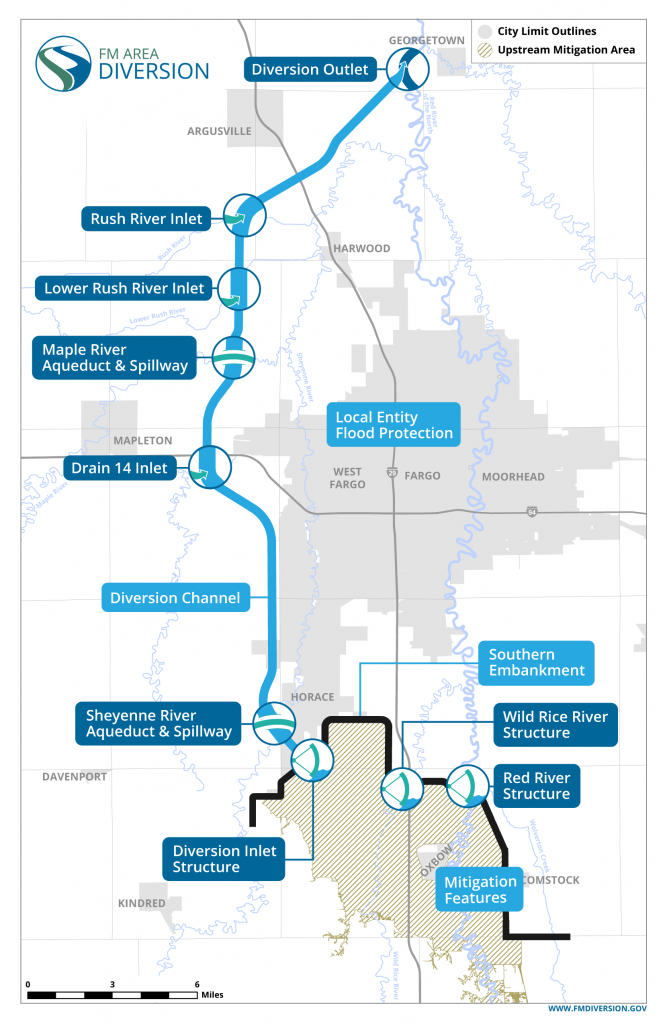May 7, 2024
Sowing Seeds of Resilience for FM Area Producers
By Jodi Smith, MFDA Director of Lands & Compliance
With the extensive urban growth of Fargo, Moorhead and West Fargo, it might be easy to lose sight of what put the Red River Valley on the map: farms and farmers with a mission to feed the world.
Since the 1800s, ag producers have weathered drought, wind, rain and disease. They’ve tilled and planted, nurtured seedlings, and harvested the fruits of their labor. We can’t risk damaging or losing this industry.
As the FM Area Diversion project works to tackle one of Mother Nature’s regular occurrences – flooding – we’re also working to protect those whose livelihood relies on not only hard work but the right mix from Mother Nature.
PROTECTING PRODUCERS
Each year, there’s about a 5% chance the FM Area Diversion will operate. When it does, water will back up in the upstream mitigation area. The area lies upstream of the Fargo-Moorhead area and, when gated structures close on the Red River and Wild Rice River, water will be held behind the 22-mile southern embankment.

The depth and the duration of the water stored in this area will depend on the flooding severity. During that timeframe, thousands of acres may experience more water than they normally would during a flood of that magnitude without the project.
When this happens, there’s a risk that farmers may be delayed in getting into their fields for spring planting. In the highly unlikely case of a late spring or early summer flood that may occur after planting, there could be direct crop damage.
To ensure farmers don’t need to worry about adverse impacts of flood protection, we have been working with Alex Offerdahl and Watts & Associates to develop no-cost crop insurance programs for producers in the upstream mitigation area. We sincerely appreciate those who have served on focus groups with Alex and helped pick holes in the programs so that we can refine and improve them. Their actions will help us provide the most complete coverage to mitigate risk.
REAPING RESILIENCE
Three key programs are being developed, two of which are focused solely on ag producers and the risks they may be exposed to during diversion operations.
Prevent-Plant Crop Insurance Program: If, as a result of diversion operations, producers are unable to plant crops by the established late-planting dates set by federal crop insurance, the MFDA-provided coverage will reimburse producers at the same coverage level that they purchased through federal crop insurance. The program also ensures that the actual production history, or APH, yield is not adversely affected if diversion operations result in a reduced yield.
Growing Season Supplemental Crop Loss Insurance: This program will cover 100% of any crop loss that may be experienced during the growing season in the unlikely event that a summer flood would require the FM Area Diversion to operate. It also will compensate organic producers for any contamination that could occur on their land.
Post-Operation Debris Removal and Cleanup: All land in the upstream mitigation area, whether used for agricultural purposes or not,will have debris removed and any damage to non-structural property repaired, remedied or restored after project operations conclude.
FOSTERING FAIRNESS
Through the years of discussions and planning, those who may experience negative impacts from the FM Area Diversion have been top of mind. Whether it’s ensuring fair buyouts and providing relocation assistance or providing our producers with the peace of mind that their livelihood will not be negatively impacted, my team and I will continue to work tirelessly to provide fairness and protection.
